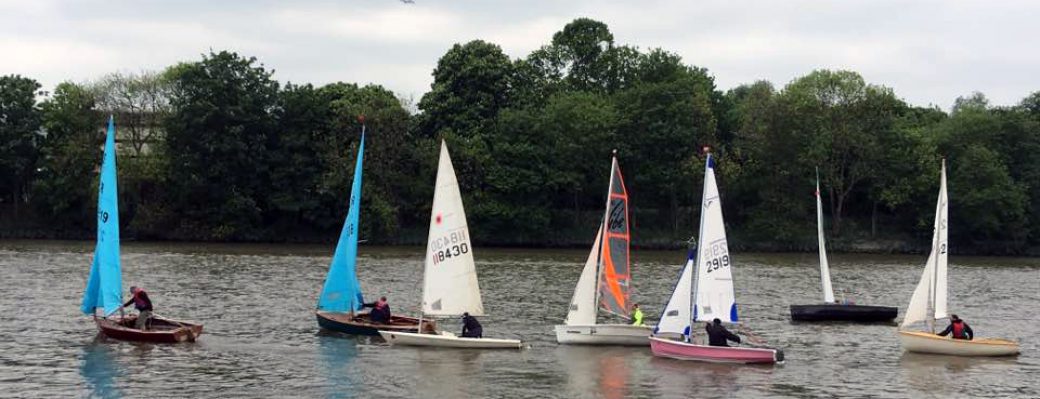History
The beginning
On 4 April 1946, 22 people met in the Club Room of the Bell and Crown pub in Chiswick and unanimously resolved to form a sailing club. The Minutes tell us that a spirited discussion took place which resolved the club rules, the design of the burgee, the officers of the club, and that there should be a monthly club meeting at the Bell and Crown for the next 6 months. The Strand on the Green Sailing Club was born.
The first season – sailing
The Club held its inaugural cruise on Good Friday, 19 April 1946 “in brilliant sunshine but alas! no wind”. A flotilla of 10 boats with 38 sailors drifted up to Isleworth and drifted back with the tide. Some things don’t change. Five boats entered the first race, which was held on 4 May 1946 in brilliant sunshine and a gusty NE wind. The course was what we now know as a B course: down stream towards Chiswick Bridge and back. Much frantic gybing was reported on the downstream leg and, a sign of those distant times, conflicts with heavy river traffic. The race was won by J Cleyndert (whose grandson and great grandson now sail at Strand) and the results were used to establish the forerunner of the present Strand handicap system.
The second race (12 May) was from the Bell and Crown to the London Apprentice. Six boats took part: Porpoise, Ripple, Windrush, Seal, Walnut and Winkle. Porpoise crossed the line4 seconds ahead of Ripple despite having to lower her mast under the bridge. Seven minutes separated Porpoise from Winkle at the tail whose performance was enhanced by the helm (one Colonel Lloyd) holding his 14th Army Burma slouch hat “approximately in the position of a spinnaker”.
The third race was Isleworth-and- back (our present C course). Five entered, four started and two finished: squally winds, strong tides and a leak took their toll. Porpoise was again mentioned in dispatches: after a slow start she rounded the upstream mark (moored boat Cockle) in style, acquiring a cigarette from the Commodore’s wife in the stern of Cockle and having it lit by the time the crew had the centreboard up for the run home. She finished a minute behind Ripple, sailed single handed by Mrs Worthington. Porpoise’s helm then left for the Royal Armoured Corps and the chronicler notes that “if he handles his tank as he does his boat, he should be at least a Brigadier by the time he comes back”.
Other 1946 events
In September there was a regatta. The first event was a ‘dinghy pulling race’ from the Bell and Crown to the railway bridge. Next came the ‘Dinner Plate Race’: no limit to crew; propulsion by dinner plate. After “some domestic argument” saucepan lids were substituted for dinner plates. It was a very wet event, more because of the energies of the crews than the rain. The sailing event entailed making sail and getting under way from a buoy, carrying a straw-stuffed boiler suited dummy as crew. At a given signal the dummy was dropped over-board as the boat sailed on upstream. At a second signal the boat came about and retrieved the dummy, sailed back to the mooring and stowed sail. Penalty points were deducted for poor style (sail in water) and the incorrect recovery of the body (should be over the transom). Mr and Mrs Worthington tied for first place.
In the winter season there was a talk from the PLA, a seamanship quiz, and film evenings showing pre-war cruising off Holland and France and earlier scenes of Strand.
So ended SGSC’s first season.
We are grateful to our enterprising founders. For 56 years the club has upheld the tradition so clearly established in that first season: the equal and mutually enhancing enjoyment of good company, good fun and good sailing.
The Arch
In the early days, boats were moored in the river. Then in 1964 the arch under Kew railway bridge was acquired after long negotiations, and has been rented from British Rail and its heirs ever since. The ramp was built during 1964 and underwent a major improvement in 2011. Until 2000, this sumptuous “clubhouse” had no electricity or running water, except that which we “borrowed” from kindly neighbours on special occasions. Fortunately the building of new housing next door to our site and the generosity of its developers helped us to install water, electricity and even a loo. Luxury indeed.
Gins Farm
In the 1960’s Michael Kemlo reconnoitred the south coast in his open car, hoping to find a suitable launching place for Strand dinghies to take to the ocean. Down a winding lane and a stoney track in the New Forest he discovered Gin’s Farm, an outpost of the Royal Southampton Yacht Club, where he tentatively enquired about use of their ramp. The welcome was warm – meals in the clubhouse and camping facilities were also offered, and more than 40 years later, SGSC still enjoys RSYC’s hospitality every summer. A motley collection of dinghies is based in their car park among the yachties’ BMWs and 4x4s, and 2 or 3 days of excellent Solent and Beaulieu River sailing is enjoyed. The party is usually even larger for the Saturday evening meal in the club.

